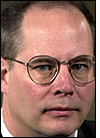For this year’s NASCAR racing season, Goodyear is using RFID to track the roughly 200,000 tires used throughout the NASCAR season at all three race series—Nextel Cup, Busch and Craftsman Truck—as part of a tire-leasing program. NASCAR organizers requested the leasing program as a means of evening the playing field.
Previously, each NASCAR racing team purchased the 10 or 12 sets of Goodyear tires it would use in a typical weekend of racing. All NASCAR vehicles are required to use the same tires. The best-funded teams purchased additional tires, however, often leaving them with a surfeit of unused tires following a race. NASCAR felt that by using these extra tires during practice sessions, these teams gained a competitive edge over teams unable to purchase as many.
Now, each team leases sets of tires for each event and must return them all—whether used or not—at the end of the race. Since RFID tags are embedded into the tires during the manufacturing process, Goodyear is using them both to automate the leasing process and to track the tires from the point of manufacture, through distribution and on to the NASCAR races. The tire maker deployed the tracking and leasing program this year after completing a successful pilot project at the NASCAR Craftsman Truck Series race at Homestead-Miami Speedway last fall (see RFID Tracks Tires at NASCAR). Goodyear conducted the pilot to ensure that the inlays could withstand the intense heat and pressure to which they’re exposed during races, where drivers sometimes exceed 200 miles per hour.
“The RFID tags have performed extremely well,” says Stephen Roth, director of Goodyear’s vehicle systems division, “and when the tire comes back after the race, we find that the tags have lived through just about whatever [the drivers] throw at them.”
Calgary-based Advanced ID is providing the UHF 915 MHz ISO 18000-6B passive RFID tags Goodyear embeds into the racing tires during manufacture. The company recently announced it had received its second purchase order from Goodyear, which plans to embed the RFID tags in all racing tires used in the 2007 NASCAR season. At some point next season, Roth notes, Goodyear will switch from the ISO 18000-6B inlays to ones compliant with the new ISO 18000-6C standard. Once again, Advanced ID will be the supplier. ISO 18000-6C matches the EPC UHF Gen 2 standard (see Gen 2 EPC Protocol Approved as ISO 18000-6C).
“We went through the basic learning curves,” Roth recalls, in regard to establishing the distribution tracking system and the leasing program at the NASCAR events this season. “And every time we set up for a race, we’re basically setting up a warehouse operation in the middle of a racetrack,” where there are many different communication systems and other factors that can cause RF interference. Therefore, the Goodyear team must survey the RF activity in the area where it plans to set up its tire corral for each event, and ensure that the handheld interrogators its staff uses—Psion Teklogix‘s 7535 handheld computer with an RD7950 UHF RFID interrogator attachment—will operate properly. Roth notes that the Advanced ID tags inside the tires can generally be read from a distance as great as 18 to 32 inches.
At Goodyear’s Akron, Ohio, headquarters, a machine embeds an inlay automatically into each NASCAR tire’s sidewall during manufacture. As the tires come off the manufacturing line, interrogators collect each tag’s unique ID (which Advanced ID pre-encodes to the tag) and send it to a database. There, it is stored and linked to the tire’s date of manufacture and other product information. As the tires are taken to trucks headed for Goodyear’s Charlotte, N.C., warehouse, interrogators installed at portals read the tags again and update the database to show the tires’ movement. Later, as trucks at the warehouse are loaded with the roughly 2,500 tires needed for each race (each event in the three series generally spans two days), the tags are read again using portal readers, and the tracking software is updated with the race site to which the tires are headed.
At the track, Goodyear personnel use the Psion handheld RFID-enabled computers to queue up a team name and read the tags embedded in that team’s tire allotment. Each group of tires is then given to its respective team, which must use them during the upcoming race and return them all to the Goodyear personnel upon the event’s conclusion. Tires used during the race are then read and later destroyed, whereas those not used are read and returned to inventory. Roth explains that the data collected on each tire during the onsite leasing process is then updated to the main database, which Goodyear created in-house. Psion worked with Akron software integration firm CTI to create an application program interface with the Goodyear software, linking the handhelds into the tire maker’s platform.
In coming seasons, NASCAR might work with Goodyear to deploy other applications for the tags. NASCAR officials, for instance, may carry handheld readers to verify, just before a race starts, that only tagged Goodyear tires are on each car.
“What we learn from racing, we take out to other areas of our businesses,” says Roth. “We are using [the RFID tracking] program as a model for the retail operations. This has been a tremendous learning experience.” Specifically, Roth’s team is learning how and where to establish reading points in its supply chain, and how to integrate RFID tag data with Goodyear’s existing IT systems, such as enterprise resource planning and warehouse management software.


